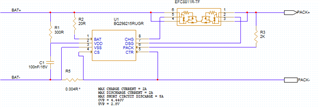Other Parts Discussed in Thread: BQ2970
Hello
I have started to develop a battery protection circuit, and decided to use BQ298215RUGR.
The problem isn't the implementation but the OVP. I can read several places that a single lithium-ion battery can get damaged with higher voltage than 4.2V
The BQ298215 has a OVP (over voltage protection) at 4.440, isn't this way to high?
I can't see in which application this will be used then, because all the lithium-ion batteries I have found is 4.2V+-0.3ish (like USE-18650-2600MAH)
Am I misunderstanding the term, or is this the wrong approach to a battery protector? 

